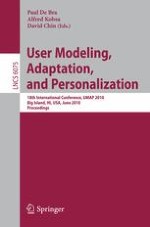2010 | Book
User Modeling, Adaptation, and Personalization
18th International Conference, UMAP 2010, Big Island, HI, USA, June 20-24, 2010. Proceedings
Editors: Paul De Bra, Alfred Kobsa, David Chin
Publisher: Springer Berlin Heidelberg
Book Series : Lecture Notes in Computer Science
